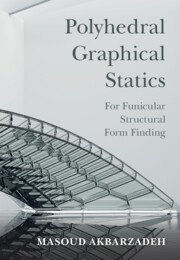Book contents
- Frontmatter
- Dedication
- Contents
- Contributors
- Foreword
- Foreword
- Preface
- Acknowledgments
- Introduction: A Brief History
- 1 Equilibrium of a Single Node
- 2 Equilibrium of a System of Forces
- 3 Compression-Only Form Finding
- 4 Articulated Compression-Only Forms
- 5 Systems with Combined Tension and Compression
- 6 Geometric Degrees of Freedom in Design of Form and Force Diagrams
- 7 Algebraic Formulation for Polyhedral Graphic Statics
- 8 Broader Applications of Polyhedral Graphic Statics
- References
- Index
2 - Equilibrium of a System of Forces
Published online by Cambridge University Press: 13 March 2025
- Frontmatter
- Dedication
- Contents
- Contributors
- Foreword
- Foreword
- Preface
- Acknowledgments
- Introduction: A Brief History
- 1 Equilibrium of a Single Node
- 2 Equilibrium of a System of Forces
- 3 Compression-Only Form Finding
- 4 Articulated Compression-Only Forms
- 5 Systems with Combined Tension and Compression
- 6 Geometric Degrees of Freedom in Design of Form and Force Diagrams
- 7 Algebraic Formulation for Polyhedral Graphic Statics
- 8 Broader Applications of Polyhedral Graphic Statics
- References
- Index
Summary
This chapter introduced the geometric steps of construction to find the equilibrium for concurrent and non-concurrent systems of forces in both 2D and 3D. It showed that constructing the force polygon in 2D and the closed force polygon in 3D as a force diagram ensures that the sum of the forces in the system is zero. In addition, we learned that constructing a closed funicular polygon in 2D and a closed funicular polyhedron in 3D in the form diagram guarantees moment equilibrium in the system. We need both constructions to have a complete equilibrium. Various configurations of forces in 3D were introduced, and the process of finding the resultant by constructing the closed force polyhedron and funicular polyhedron was discussed. Ultimately, we showed how it is possible to design various hanging sculptures similar to those of Alexander Calder using geometric construction of forces and finding resultants in 2D. The design of such sculptures in 3D was pursued by subdividing the force diagram and locating equilibrating forces in the form diagram. With this introduction to equilibrium and funicular construction, we are ready to move to the next chapter, where the funicular construction for specific boundary conditions is discussed, and the principles of compression-only or tension-only structural form finding for architectural structures will be explained.
Keywords
- Type
- Chapter
- Information
- Polyhedral Graphical StaticsFor Funicular Structural Form Finding, pp. 71 - 98Publisher: Cambridge University PressPrint publication year: 2025

